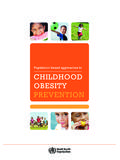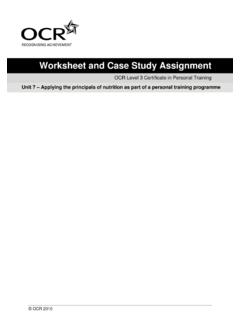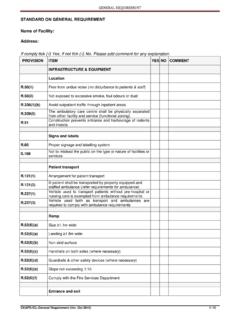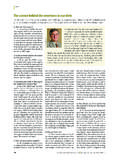Transcription of Food and drink labelling - Label: Home
1 food and drink labelling :A tool to encourage healthier eating Seeing the energy, fat, sugars and salt in a food at a glance can help patients check and compare similar products and choose those with lower energy or less fat. The more they compare products the more they become aware of what s in the food they re eating. Nigel DenbyRegistered Dietitian and Head of Nutrition at to labelling on products sold in the UKSince the legislation came into force on 13 December 2014 most labels have already changed, but it takes time to change every label over so for a while you may see both old and new style labels in the labelling is a useful tool which informs people about their food choices. Although this legislation has resulted in changes to the labels of nearly every food and drink product on sale in Europe, people need not be intimidated or put off by these changes. With this guide we aim to de-mystify some of the changes that have been introduced under this legislation; in doing so we hope to equip individuals with the information they need to adapt to the new food labels and use them with confidence.
2 1. The regulation s full name is the EU Regulation 1169/2011 on the provision of food information to consumers Labels on pre-packaged food and drinks have changed due to a new European Regulation1. This new piece of legislation is designed to make food labelling easier for people to use. Foreword3 Barbara Gallani, Director of Regulation, Science and Health at the food and drink FederationFood and drink labelling as a tool for healthy eating IntroductionAt , an online community for nutrition in early years, we know some people find food labels confusing, however they needn t be. We are delighted that FDF has produced this resource to help explain nutrition the energy, fat, sugars and salt in a food at a glance can help patients check and compare similar products and choose those with lower energy or less fat. The more they compare products the more they become aware of what s in the food they re label can also help clearly show patients the difference that portion size can make.
3 Think about asking someone to compare the different energy and nutrient levels between different sizes of snacks, like chocolate or crisps, before making their choice. Or ask patients to consider the impact of eating one, two or three sausages before they start cooking their evening meal. Just making someone stop and think before they buy or cook can really help impact on their dietary patients to use the labels can also help them decide when they are happy to be indulgent. For instance, they might choose to save their favourite full fat mayonnaise to have with prawns, but use a low fat mayo in sandwiches or coleslaw. Then again, they could also use labels to keep a tally of their fat intake over a day or a week - this might help them decide if they can afford to be indulgent at all!On top of this, labelling provides other essential information, such as any allergens contained within a product, which is need-to-know information for all of those who suffer from allergies (as well as their families and friends).
4 I hope that you find this guide useful in your work as a healthcare professional and it helps you to help your patients understand food Denby Registered Dietitian Head of Nutrition : Changes to labelling on products sold in the UKIntroduction: food and drink labelling as a tool for healthy eatingContentsSection 1: Reference Intakes (previously Guideline Daily Amounts)Section 2: Front of pack labellingNutrition information on the front of packUsing front of pack labels to check, compare and choose Variations on front of pack labels Section 3: Other information on product packagingMandatory nutrition labellingIngredients list Allergen informationSection 4: Why nutrition and health claims can be trustedFurther resources 345678910111213145 The reference intakes for fat, saturates, sugars and salt are all maximums and not targets to aim term Guideline Daily Amount (GDA) has been replaced with Reference Intake (RI) however the principles behind how these values are determined remains the Intakes (previously Guideline Daily Amounts)This is the first time that the actual values have been set out in European Law.
5 RIs are given for all of the mandatory nutrients (below). However, unlike with GDAs where values existed for men, women and children, for simplicity there is now only one set of RIs (below).Energy or Reference nutrient IntakeEnergy 8400kJ / 2000kcalTotal fat 70gSaturates 20gCarbohydrate 260gSugars 90gProtein 50gSalt 6gAlthough the RI values are for an adult , they are actually based on the requirements for an average female with no special dietary requirements and an assumed energy intake of 2000 kcal. Reference Intakes for energy and selected nutrients (adults)Although there were previously child GDAs, Reference Intakes for children do not exist under the new 1: Reference Intakes (RI)6 IMPORTANT. This information is a guide only and is not individual checking the portion information a individual can keep track of what they will always be in this order so, for example, if a patient is watching their salt intake, this will always be the last of pack nutrition labels will show either: Energyor Energy | Fat | Saturates | Sugars | SaltAlthough labels have changed, most packaged food and drink products will continue to show simple nutrition information on the front of pack which is provided voluntarily by information on the front of packof an adult s Reference values (as sold) per 100g: Energy 993kJ/235kcalEach slice of bread (40g) contains:Energy397kJ94 %2% % example Label: All of this information will be provided in grams (g) apart from energy which now appears in kilojoules (kJ) and kilocalories (kcal).
6 This information will also normally be provided as a percentage of the Reference Intake, the new term for Guideline Daily the nutrition information on a label will be given in a portion or unit and this will be shown immediately next to the label per of a pizza or per slice .Section 2: Front of pack labelling7 IMPORTANT. People often use calories and energy interchangeably. If an individual is watching their calorie intake, it is important to look for the number in the energy icon that is followed by similar foods, such as the shepherd s pie and lasagne below, to see how the nutrient content of the similar products s a good idea to think about what else is eaten at mealtimes and what effect that may have. For example, if a lasagne is bought is that eaten with garlic bread, salad or oven chips? And what about dessert?TIPThe front of pack label allows individuals to:l Check what their food contains - how much energy and how many grams of fat, saturates, sugars and salt plus how much of their Reference Intakes this contributes tol Compare foods they buy with other similar foodsl Choose the foods that best suit their needsThe label also allows people to:l Keep an eye on portion sizel Focus on the nutrients that are important to theml See how individual foods fit into a balanced dietUsing front of pack labels to check, compare and chooseIMPORTANT.
7 Getting into the habit of using the front of pack label to check the content of foods on a regular basis can make individuals more conscious of what they are s Pie (per pack) Energy1931kJ461 kcalFat19g23%2 7%5 0%2% labels:of an adult s Reference values (as sold) per 100g: Energy 455kJ/109kcalLasagne (per pack)Energy2549kJ609 kcalFat32g30%4 6%80%11% 7% an adult s Reference values (as sold) per 100g: Energy 655kJ/157kcal8 Section 2: Front of pack labellingAs well as the information already covered in the previous pages, some labels will have a traffic light colour (red, amber and/or green) overlaid on top of the nutrition information, along with the Reference Intake information. The colour coding is a UK-wide government scheme and provides an indication of whether there is a high, medium or low amount of the nutrient per 100 that the basic elements of a label on the front of pack are set down in European law there is greater consistency in what will be seen on pack, no matter what the individual brand or which supermarket someone shops on front of pack labelsIMPORTANT.
8 Sometimes products may have a similar colour code but still have different nutrition information. The detailed RI information can help individuals choose between products that have the same colour. See the example below which shows how the RIs can help choose between two similar pizza 1 (per pizza) Energy1601kJ383 kcal19%Example labels:Front of pack labelling can help inform choices by giving information about some nutrients. However, it cannot be a substitute for advice on how someone can achieve a healthy and balanced diet, which might include, for example, recommendations to increase certain foods like fruit and vegetables and oily fish, or nutrients like 3%3%4 3%Pepperoni pizza 2 (per pizza) Energy2174kJ519 kcal26%5 5%5%3 2%3 1%of an adult s Reference values (as sold) per 100g: Energy 1322kJ/316kcalof an adult s Reference values (as sold) per 100g: Energy 1229kJ/294kcal9 Section 2: Front of pack nutrition labelling Nutrients will have to be listed in a certain order energy (both in kilojoules and kilocalories) and the amounts of fat, saturates, carbohydrates, sugars, protein and salt (in place of sodium which is no longer permitted).
9 The information has to be given per 100g/ml but can additionally be given:l Per portion or per consumption unit ( per slice) l As % Reference Intakes (formerly known as Guideline Daily Amounts) Information on the following nutrients can be provided in a voluntary basis: mono and poly-unsaturates, polyols, starch and fibre. Information on certain vitamins and minerals can be given if listed on an approved list and present in significant is now mandatory for food and drink manufacturers to provide nutrition information on almost all food and drink1; you ll usually find this on the back of product now has to be listed on pack instead of sodium. This change makes it easier for individuals requiring a diet lower in salt to choose between products on Exemptions from mandatory labelling are listed in Annex V of the Regulation2 Approved vitamins and minerals are listed in Annex XIII of the RegulationSection 3: Other information on product packaging10 IMPORTANT.
10 If a nutrition claim is made then it becomes mandatory to give information about that nutrient, even if it is not listed in the regulation. For example if the claim high in omega 3 was made then the amount of omega 3 per 100g would have to be amount of the ingredients used in a product will also be stated where:(i) The ingredient ( steak and kidney pie) or category of ingredients ( vegetable pasty) appears in the name of the food . (ii) It is usually associated with that name by the consumer lamb in a shepherd s pie. (iii) It is emphasised on the labelling in words, pictures or graphics strawberry in a yogurt described as having chunks of real strawberry . (iv) The ingredient is essential to characterise a ingredients list can also help if someone wants to look for, or avoid, a certain ingredient. For example:1) Vegetable oils and fats can be grouped together in the ingredients list under the term vegetable oils or vegetable fats but this must be followed by the type of vegetable origin ( palm, sunflower or rapeseed) and the phrase in varying proportions.



